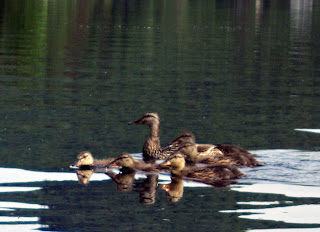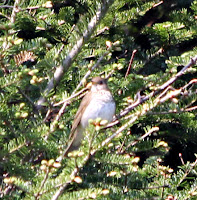 |
| The Wednesday morning birders are savvy and very welcoming |
The
Joppa Flats Nature Center in Newburyport, MA is a wonderful MA Audubon facility located on the Merrimac River. One of its popular birding programs is the Wednesday morning outings. An accomplished group of regulars goes on these walks and for some time, I’ve wanted to attend one. Today, I got the opportunity and it was a blast.
About 20-25 folks showed up and we took the two Center vans and several other vehicles and launched for some inland birding. The objective was to visit a heron rookery -- the largest in Eastern Massachusetts, and stop at a swamp/wetlands along the way.
We got to the Crane Natural Area which features hundreds of dead trees and a variety of birds. We just got out of the vehicles when we heard a Great Crested Flycatcher call from and area of dense foliage. Bill, our leader, got out his recording, played it, and out popped the flycatcher, flying down to a dead tree, giving us all a wonderful look. It hung around, calling and letting us know whose territory it was.
When you have five or ten good birders, it makes you a little better - or at least it does me. We were all seeing a Baltimore Oriole with an active nest, an Eastern Bluebird, and a very cooperative Willow Flycatcher that popped up to a call and posed nicely. We watched a Belted Kingfisher for some time as it dove and returned to perches. It was a great stop with about 20 species seen.
 |
| About 70 heron nests were at the rookery. |
After a winding drive through some fairly rural parts of the county, we arrived at the Carter Fields and walked down to the observation platform at the heron rookery. About 70 heron nests were there in the dead trees with fifty of them occupied. Given the size of the youngsters, we guessed that some had already fledged and many more were about ready to go.
 |
| Mama (or Dad) bring home chow to the growing youngsters. |
We watched their parents bring back food and noted that some of the kids sort of stretched out to look bigger (and get fed first.) A couple of green herons and a massive snapping turtle added to the mix. It was a very impressive site and fun to take some time and watch.
On the way back to the vans, we heard a Pileated Woodpecker which teased us for about 20 minutes as we moved and played a recording, and listened. We finally gave up and were leaving as a caravan, when in a flurry of brake lights told us that Bill, in the first car, had seen the bird. We all piled out but it had flown off -- but it gave me an insight of the tenacity of some birders.
Going home, the guy driving our van told me , “Nearly everything I know about birding I learned at these Wednesday sessions.” After today, I can see why. Clear teaching from the leaders, mentoring from other experienced birders, and a wonderful array of birds, make for great outings. I liked how they welcomed a newcomer -- I’ll be back again. Give it a try if you are in eastern Massachusetts on a Wednesday.














